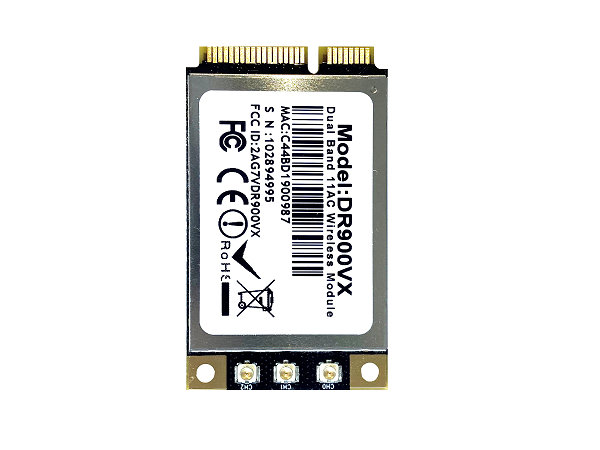MT7915 and QCA9880: the duo in wireless connectivity
In the field of wireless connections, two high-profile chips, MT7915 and QCA9880, each exhibit unique characteristics and are suitable for different application scenarios.
MT7915 is an efficient dual-core network accelerator platform that supports Linux and OpenWRT OS. Used with the MT7915D, it can provide rates up to 1200Mbps in the 5GHz band and up to 574Mbps in the 2.4GHz band. As a single-chip Wi-Fi 6 Wave 1+ and Bluetooth 5 combined solution, MT7915 integrates a dedicated RF receiver and "zero-wait DFS channel monitoring" to bring users faster, more reliable, and easier-to-use connections.
In comparison, the QCA9880 is a highly integrated wireless local area network (WLAN) system-on-chip (SoC) suitable for 5GHz 802.11ac or 2.4/5GHz 802.11n WLAN applications. It incorporates an onboard CPU for low-level setup of the WLAN physical layer (PHY) and RF to offload the host processor to perform other tasks. Supports high-performance 3x3 MIMO, suitable for wireless applications with extremely high requirements on link quality, throughput and range. Implements half-duplex OFDM, CCK and DSSS PHY, supporting 802.11ac 80MHz channel operation at 1.3GBps, and 802.11n up to 216.7Mbps at 20MHz and 450Mbps at 40MHz channel operation.
In terms of design and manufacturing, MT7915 adopts efficient process nodes and integrated design to provide excellent performance and power consumption. In contrast, QCA9880 reduces the need for external components and improves system reliability and stability by integrating more hardware modules and functions.
In terms of scalability, QCA9880 provides a wealth of interfaces and expansion options, making systems based on this chip easier to upgrade and expand. The scalability of MT7915 depends on the specific design and application scenarios.
To sum up, MT7915 and QCA9880 each have their own advantages and disadvantages in the field of wireless connection. Known for its efficient network acceleration and Wi-Fi 6 technology, MT7915 is suitable for routers and access points that require high-speed and reliable connections. QCA9880 is recognized for its highly integrated and robust MIMO technology and is suitable for enterprise-level WLAN applications and scenarios with extremely high range and throughput requirements.
In actual applications, which chip to choose depends on specific needs and budget. For applications that require high performance, high speed, and reliable connectivity, the MT7915 may be a better choice. For WLAN applications that require a high degree of integration, robust performance and scalability, the QCA9880 may be more suitable.
Overall, MT7915 and QCA9880 are two outstanding chips in the field of wireless connectivity, each performing excellently in specific application scenarios. Understanding their pros and cons and choosing based on your actual needs will help achieve the best wireless connection performance.

-
MT7915+MT7975?Chipset
-
2.4GHz max 23dBm & 5GHz max 20dBm output power?
-
IEEE 802.11ac?/ ax compliant & backward compatible with 802.11ax/ac/a/b/g/n?
-
2×2 2.4G & 2×2 5G? MIMO Technology, up to 1.8Gbps Mini PCI Express edge connector?
-
SupporttheFrequency2412MHz~2482MHz
-
SupporttheFrequency5180MHz~5825MHz
-
RoHS compliance ensure a high level protection of human health and the environment from risks that can be posed by chemicals??
-
Supports Spatial Multiplexing,Cyclic-Delay Diversity (CDD), Low-Density Parity Check? (LDPC) Codes,Maximal Ratio Combining (MRC), Space Time Block Code (STBC)
-
Supports IEEE 802.11d, e, h, i, k, r, v time stamp, and w standards?
-
Supports Dynamic Frequency Selection (DFS)?
-
CardsareindividuallycalibratedforQualityAssurance

-
Qualcomm-Atheros?QCA9880?chipset
-
2.4GHz max 26dBm & 5GHz max 25dBm output power?
-
IEEE?802.11ac?compliant & backward compatible with 802.11a/b/g/n?
-
3x3 MIMO Technology, up to 1.3Gbps?
-
Mini PCI Express edge connector?
-
RoHS compliance ensure a high level protection of human health and the environment from risks that can be posed by chemicals??
-
Supports Spatial Multiplexing, Cyclic-Delay Diversity (CDD), Low-Density Parity Check (LDPC) Codes, Maximal Ratio
-
Combining (MRC), Space Time Block Code (STBC)?
-
Supports IEEE 802.11d, e, h, i, k, r, v time stamp, and w standards?
-
Supports Dynamic Frequency Selection (DFS)?
-
FCC,CE and IC Certification
By:Wallystech
本文来自互联网用户投稿,该文观点仅代表作者本人,不代表本站立场。本站仅提供信息存储空间服务,不拥有所有权,不承担相关法律责任。 如若内容造成侵权/违法违规/事实不符,请联系我的编程经验分享网邮箱:veading@qq.com进行投诉反馈,一经查实,立即删除!